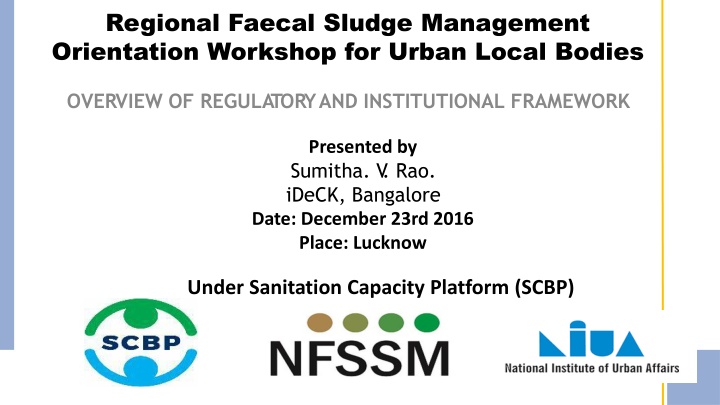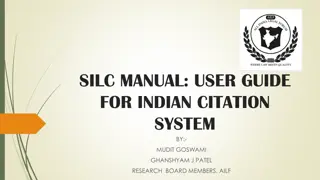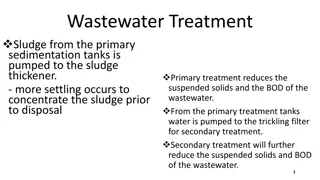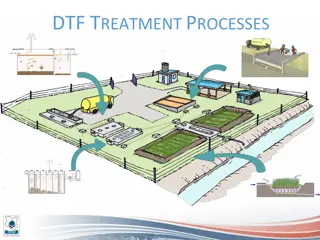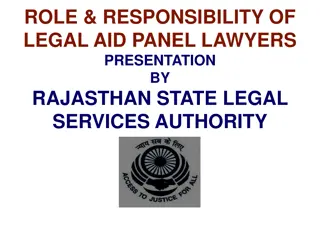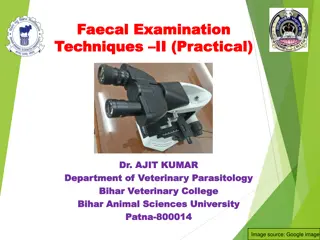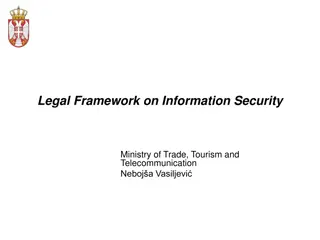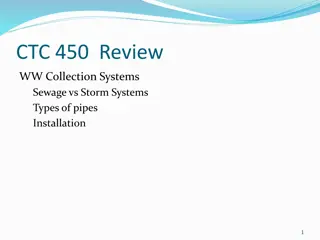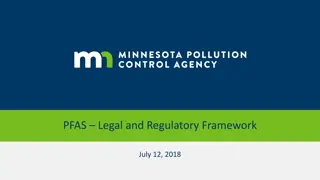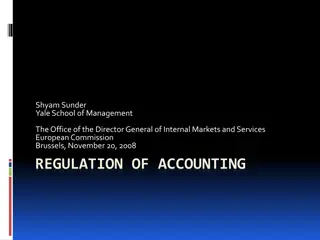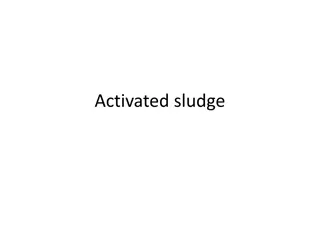Legal and Regulatory Framework for Faecal Sludge Management in India
This overview discusses the legal and regulatory framework surrounding faecal sludge management in India, highlighting the current gaps and challenges. It touches upon the absence of specific sanitation laws at both central and state levels, the constitutional basis for the right to sanitation, and the role of environmental laws in regulating faecal sludge disposal. The presentation emphasizes the need for comprehensive legal interventions to ensure safe handling and disposal of septage.
Download Presentation

Please find below an Image/Link to download the presentation.
The content on the website is provided AS IS for your information and personal use only. It may not be sold, licensed, or shared on other websites without obtaining consent from the author.If you encounter any issues during the download, it is possible that the publisher has removed the file from their server.
You are allowed to download the files provided on this website for personal or commercial use, subject to the condition that they are used lawfully. All files are the property of their respective owners.
The content on the website is provided AS IS for your information and personal use only. It may not be sold, licensed, or shared on other websites without obtaining consent from the author.
E N D
Presentation Transcript
Regional Faecal Sludge Management Orientation Workshop for Urban Local Bodies OVERVIEW OF REGULA TORY AND INSTITUTIONAL FRAMEWORK Presented by Sumitha. V . Rao. iDeCK, Bangalore Date: December 23rd 2016 Place: Lucknow Under Sanitation Capacity Platform (SCBP)
Sanitation Capacity Building Platform What is it? What is it? Collaborative effort by NIUA for Mainstreaming Fecal Sludge Management at the state level and national sanitation agenda. Working with Expert Partner organsiations for FSM solutions, upscaling of capacity building and national level advoacy with the NFSSM group. We can help you! We have sanitation challenges! ULB WASHi 2
Legal and regulatory framework for FSM1 Background Presently there exists no specific sanitation law either at central level or at any state level dealing exclusively with safe handling, transport and disposal of septage in a holistic manner There exist no comprehensive legal framework on sanitation or safe disposal of faecal sludge. Environmental laws, municipal laws, different national and state level policies and programmes regulates the right to sanitation and sanitation services in a piecemeal manner Sanitation laws in India stem from Constitution of India Environmental (Protection)Act, 1986 The Water (Prevention and Control of Pollution)Act Legislations for prohibition of employment as Manual Scavengers and their Rehabilitation 2
Legal and regulatory framework for FSM2 Constitution of India The right to sanitation in India takes its legal basis mainly from fundamental rights enshrined in the Constitution and most importantly fundamental rights to life Judiciary decisions has interpreted fundamental right to life (Article 21) to include right to sanitation/right to clean and wholesome healthy environment Directive principles casts duty upon the government to create conditions through legal and regulatory interventions to ensure right to sanitation (Article 48A) It is a fundamental duty of every citizen to protect and improve environment [Article 51-A(g)] The Concept of sanitation in India includes personal hygiene, home sanitation, safe water , garbage disposal, excreta disposal and waste water disposal Source: Nirmal Bharat Abhiyan Guidelines, GoI, 2012 3
Legal and regulatory framework for FSM3 Environmental laws Environmental ProtectionAct 1986 Scope of the Act is broad and encompass protection of various variant of environment including water, land. Government is given power to take samples of water, soil and other substance from any place for analysis Water (Prevention & Control and Pollution)Act, 1974 The purpose of Water Act is to prevents and control water pollution and restore water quality Water Act can be used as a tool to prevent illegal discharge of faecal sludge into the water bodies Lack of proper construction, overflow and opening of septic tank during rainy season results in pollution of water Practice of disposing faecal matters directly into water bodies or agriculture field also causes water pollution 4
Central Legislation on FSM4 The Employment Of Manual ScavengersAnd Construction Of Dry Latrines (Prohibition)Act, 1993 Primary legal instrument to eradicate practice of Manual scavenging Prohibits engaging in or employing for or permit to be engaged in or employed for manually carrying human excreta Executive Authority is empowered under the Act to prevent manual scavenging Contravention of the Act attracts imprisonment for a term extend to one year or with fine, which may extend continuation, day Source: Socio-Economic Caste census data July 2015 to Rs. 2000 or both. In case of with additional fine Rs.100 every Manual scavenging in context of FSM In Indian cities, most of the septic tanks are de- sludged manually. This unpleasant and repulsive job, precipitates human contact with faecal matter, and since the sludge (including fresh excreta) generally gets around the tank during emptying, this poses a risk of transmission of diseases of fecal origin in any case, this is tantamount to manual scavenging. is considered as an Primary reasons for the Act s inefficacy The Act did not address the more insidious forms of manual scavenging, such as cleaning open gutters, manholes and septic tanks which is one of the primary reason for Act s inefficacy. spilled 5
Central Legislation on FSM5 Prohibition of Employment as Manual Scavengers & their RehabilitationAct, 2013 Act has wider scope and higher penalties compared to 1993Act. The Objectives of theAct is to; prohibit employment as manual scavengers rehabilitate manual scavengers and their families prohibit manual cleaning of sewers and septic tanks without protective equipment Act regulates insanitary latrines and engaging of manual scavengers by- Prohibiting construction of an insanitary latrines and requiring owner of the insanitary latrines to demolish or convert thereof into sanitary latrines Prohibiting engaging or employing manual scavenger by any person, local authority or any agency Discharging every person engaged or employed for manual scavenging from obligation to do manual scavenging Prohibiting hazardous manual cleaning of septic tanks and sewers to ensure health and safety of workers Duty is cast on every local authority to use appropriate technological appliances for cleaning. However, no time period, funds or other directive has been given for such transition of methods of cleaning. 7
Policy initiatives in sanitation sector 2014 Swacch Bharath Mission; AMRUT and Smart City Mission 2013 Revised Manual on Sewerage & Sewerage Treatment systems 2009 Handbook on SLB 2008 National Urban Sanitation Policy 2005 Jawaharlal Nehru Urban Renewal Mission (JnNURM) 1993 Manual on Sewerage and Sewage Treatment systems The Constitution (74th Amendment) Act 1992 8
Policy Level Intervention.1 National Urban Sanitation Policy (NUSP) MoUD issued NUSP in 2008 with the primary goal to transform community-driven, totally sanitized, health and liveable cities and towns; According to this definition a fully sanitised city should have: Communities and institutions aware about sanitation. People who have changed their behaviour and have adopted practices. All urban dwellers with access to safe and hygienic sanitation facilities, so that no one defecates in the open. Strengthened national, state, city and local institutions (public, private and community), capable of planning, implementing, operate and maintain sanitation facilities. 100% of human excreta and liquid wastes from all sanitation facilities including toilets are disposed off safely. urban India into POLICY GOALS Awareness Generation and Behaviour Change Promoting proper and of sludge from on-site installations Ensuring the waste collected safely confined disposed of after treatment environment friendly way Open defecation free city disposal treatment healthy sanitation Integrated city-wide sanitation that Sanitary and safe disposal human are Proper O&M of all Sanitary Installation and in NUSP mandates states to develop state urban sanitation strategies and work with cities to develop City Sanitation Plans 9
Policy Level Intervention.3 NATIONAL WATER POLICY 2012 Water policy for the first time, recognized water for sanitation and hygiene as a problem and recommended incentives for decentralized and water-saving sanitation and sewerage system National Water Policy 2012 provides following basic principles of Sanitation Access to safe and clean drinking water and sanitation should be regarded as a right to life essential to the full enjoyment of life and all other human rights T o provide improved water supply in rural areas with proper sewerage facilities Reuse of urban water effluents from kitchens and bathrooms, after primary treatment, in flush toilets should be encouraged Urban water supply and sewage treatment schemes should be integrated and executed simultaneously. Water supply bills should include sewerage charges. 9
Institutional framework for Sanitation and Septage management Levels Entity Responsibilities Neeti ayog Govt. of India Planning and allocation of central Government funds through Five Year Plans Development of guidelines, schemes, national level policies, funding support, technical assistance Designing and implementing national-level strategies on sanitation, capacity-building, financial assistance for evaluating urban projects. Providing technical support, funding support for sanitation facilities Monitor and evaluation of programmes supervision of municipal administration coordination with related state government departments liaison with the central government and external funding agencies administrative and financial management of municipalities Ministry of Urban Development CSP, monitoring and State Govt. Urban Department Directorate of Municipal Administration (DMA) Development (UDD) & Development, promotion and implementation of State level plan, Establishment of standards for sewerage services in the state service delivery, O&M of sanitation facilities Parastatal Agencies such water and sanitation Boards Local Govt. Urban Local Bodies such as municipalities and corporations Development Authorities Planning, design, implementation, operation and maintenance of water supply and sanitation services in cities and towns Planning, implementation, O&M of sanitation services 10
Institutional framework for Sanitation and Septage management Apart from the Governmental institutional set-up, various educational institutions, corporate entities, NGO s, non-profit organisations, multi-lateral agencies such as ADB, WB and foundations such as Bill & Mellinda gates foundation, USAID are actively involved at various assistance, funding support, implementing various sanitation- based initiatives, training local communities and conducting awareness programmes. Micro-Finance Institutions are involved in providing micro-finance for setting-up sanitation facilities. levels to provide technical 11 Confidential Information 24-12-2016
State Level legal and regulatory Framework 12
Legal and regulatory Framework Background Provision primarily bodies of sanitation facilities rests with T otal Household Percentage of households having Piped sewer system 246,692,667 municipal 11.9 Septic Tank 22.2 Legal and regulatory framework on Septage management in India is focused to provide centralised piped sewer system Open 49.8 Urban Household Percentage of households having Piped sewer system Septic Tank 78,865,937 32.7 38.2 Only 32.7% of urban and 2.2% of rural households connected to piped sewer system in India are Open Percentage of households having Piped sewer system 12.6 167,826,730 Rural Household Remaining depend system like soak pits, septic tanks population on-site thus 2.2 on sanitation 14.7 Septic T ank Open 67.3 Type of Latrine System: Source: 2011 Census 13
State level legal and regulatory framework for sanitation State Water & sanitation Board Municipal Corporation Act Municipalities Act Laws governing parastatal bodies Municipal law Building and sanitation bye-laws State level policies Sanitation Policy Guidelines Manuals Building bye-laws The Municipal Laws in India are focused towards provision of centralised sewerage networking (public drain) by the local bodies and many of the provisions relating to sanitation in the law put emphasise on the function and duties of the local bodies to provide corporate drains, drainage system and sewage disposal works. As such, the municipal laws responsibilities of corporation in providing a decentralized sanitation services does not directly provide specific roles and 15
Interventions of local bodies in the septage management chain means night-soil and other contents of water-closets, latrines, privies, urinals, cess-pools etc. Construct purchase or take on lease any land, building, engine, material or apparatus for the purpose of receiving, treating, storing, disinfecting, otherwise sewage. any work or T o collect, remove, treat and dispose sewage Supply, construct and maintain receptacles, fittings pipes and other appliances to receive and conducting sewage drains distributing disposing or of into corporation Arrange preparation of compost manure from nightsoil rubbish. for & 16
Legal and institutional challenges in Septage Management Institutional issues *Limited awareness among stakeholders *Lack of clear delineation of responsibilities * Shortage/transfer of efficient trained staffs * Political changes, vested interest of local leaders Inadequate human capacity Fragmented policy framework and weak Enforcement *Poor enforcement of existing laws *Emphasis on centralised sewer system * Lack of policies on septage management *Lack of skilled labour for constructing septic tanks as per standards *Inadequate regulations for partnership with private service providers Key legal challenge 17
Thank You www.niua.org National Institute of Urban Affairs Core 4B, India Habitat Centre, Lodhi Road New Delhi 110003 011- 24617517 agupta@niua.org, jdash@niua.org
